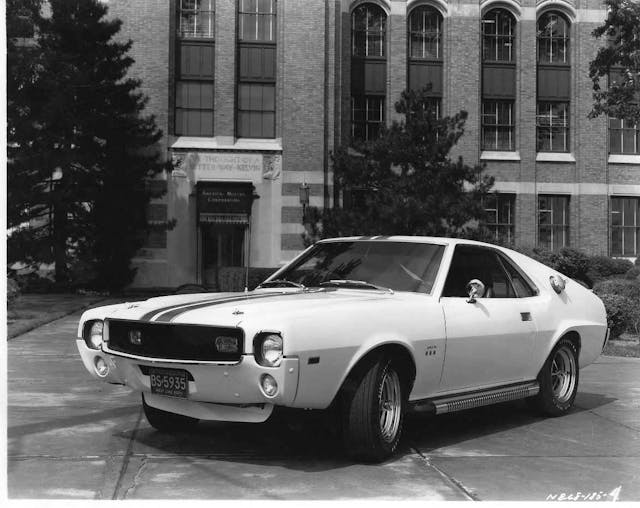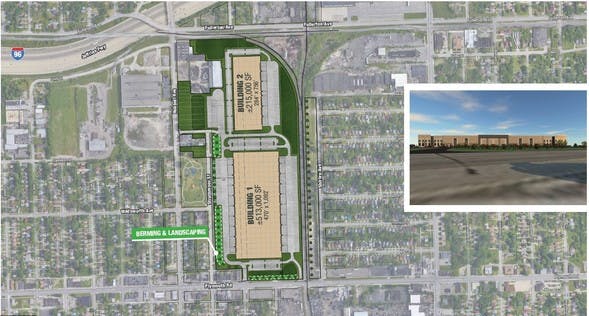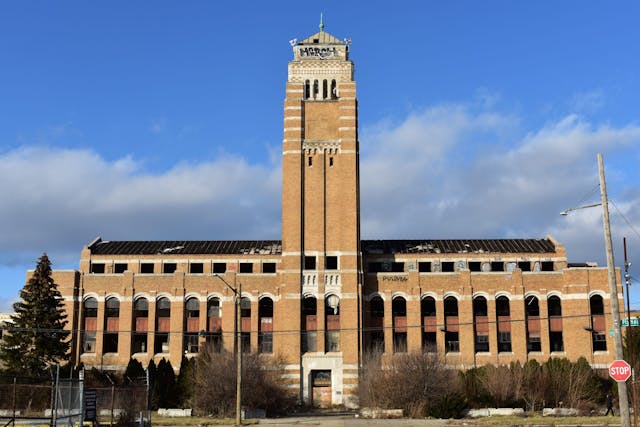Historic American Motors’ headquarters site to undergo $66M redevelopment
For more than a generation, journalists, editors, and producers of television news looking to illustrate “by-the-numbers pieces” on the dismal state of American manufacturing have flocked to Detroit’s ruins. Though neither the old Michigan Central train station nor the abandoned Packard plant on the city’s east side had anything to do with the post oil-crisis decline of the U.S. auto industry, they’ve been unjustly conscripted as poster children for domestic sector’s fall from glory.
Hope is on the horizon, however. Ford Motor Company is renovating the train depot to be part of a high-tech R&D campus and it looks like the huge Packard site will also finally be redeveloped. Lesser-known locales are also getting their chance: The latest candidate, as Detroit mayor Mike Duggan announced last month, is the former American Motors Corporation headquarters on Plymouth Road in Detroit’s west side. Abandoned for more than a decade, the complex will be the subject of a $66 million redevelopment plan.

While not as well known as some of Detroit’s other industrial hulks, the 56-acre site has a long automotive history. If you’re a fan of AMC cars or pre-Chrysler Jeep utility vehicles, there’s a very good chance that the cars and trucks you love were designed and engineered on Plymouth Road. The Javelin, AMX, Hornet, Gremlin, Rebel, AMX/3 supercar concept, George Romney’s compact Rambler, the Jeep CJ-7, and the original Jeep Cherokee and Grand Cherokee were all developed at what originally was a Kelvinator facility.
In 1925, Kelvinator introduced the first completely self-contained home refrigerators, which were so successful that the company built a new factory and management building on Detroit’s Plymouth Road, starting construction in 1926. The building is fronted by administrative offices and an eight-story Art Deco tower that dominates the mostly residential neighborhood that grew up around the facility. A quote from Lord Kelvin—”I’ve thought of a better way”—once lay in bas-relief above the front entrance. Behind the office building lies a three-story factory with internal courtyards that admit natural lighting to the plant. Eventually the complex would comprise almost 2 million square feet of industrial and office space. In early 1937, the refrigerator company merged with the Nash automobile company, apparently a condition that Kelvinator CEO George Mason extracted from Charles Nash before Mason was hired to run the car company.

During WWII, as American manufacturers switched to military production and Detroit became known as the “Arsenal of Democracy,” the factory switched from making refrigerators to making Sikorsky R-6 helicopters for the U.S. Army. After the war, Mason could see the writing on the wall for America’s independent automakers and lobbied for a merger of Nash, Hudson, Studebaker, and Packard to create a conglomerate with the resources to compete with the Big Three—GM, Ford, and Chrysler. Personality conflicts between Mason and Packard’s James Nance prevented the mega merger but, in 1954, Mason did manage to merge Nash with Hudson to create the American Motors Corporation. At the time, it was largest corporate merger in American history. The Plymouth Road facility became AMC’s headquarters and the company’s primary design and engineering center. AMC would sell off its appliance division in 1968.

The building remained AMC’s nerve center until 1975, when the company built a new office tower in suburban Southfield and moved its headquarters there. According to Mayor Duggan, then-mayor Coleman Young was so angry about the move that he vowed that neither he nor the city of Detroit would ever buy another AMC product.
Though both management and AMC’s main design staff made the move, the Plymouth Road facility became the site of Jeep’s engineering offices. That’s where Roy Lunn engineered the original Cherokee, arguably the most durable American car or truck ever made, and created the original crossover vehicle, the AMC Eagle, by mounting a Jeep drivetrain beneath a Hornet station wagon. After Chrysler’s acquisition of American Motors in 1987, the AMC building was renamed the Jeep Truck and Engineering Center. That’s where the landmark 1994 Dodge Ram pickup truck and the original Jeep Grand Cherokee, two vehicles that have proven essential to Chrysler’s continued survival, were designed and developed.

The revitalized Chrysler Corp. built an all-new headquarters and engineering campus in Auburn Hills, Michigan, moving there from Highland Park in 1996. Over the next decade more and more work was transferred from Plymouth Road out to the Auburn Hills facility. In the wake of Chrysler’s 2009 bankruptcy and restructuring, all activity at the former AMC building ceased and the property was divested as part of the bankruptcy. The building was essentially abandoned in 2010 and since then it has been the target of graffiti taggers, vandals, scavengers, and industrial spelunkers. At some point, Lord Kelvin’s quote over the front door has been effaced, though the adjacent graphics honoring science and technology remain. Hopefully, those will be preserved during the demolition.

According to the announcement by Mayor Duggan, the redeveloped property will continue to be used by the automotive sector. NorthPoint Development, a Missouri based real estate firm, will be tearing down the original Kelvinator buildings and replacing them with two all-new structures totaling more than 720,000 square feet of Class A industrial space that the company plans on leasing to an as yet unidentified automotive-parts supplier.

The city of Detroit is selling the former AMC site and 26 adjacent residential lots for almost $5.9 million to NorthPoint and it is estimated that demolition and environmental remediation will cost approximately $10M, for which NorthPoint will be responsible, although that cost will be credited against the purchase price by a tax break from the city of Detroit.

Officials say that demolition and construction will employ about 150 people and, when completed, the new facility will create more than 300 permanent, full-time jobs. Mayor Duggan described the redevelopment of the site as a step to “erase the ruin porn from the city’s landscape.” The Detroit News reports that Duggan said: “I am convinced within a couple of years, you’re going to see a manufacturing facility employing 300 or 400 people to be a source of employment in this neighborhood instead of a source of embarrassment. Before we’re done, we’re going to have this same announcement at the Packard Plant and get rid of the rest of the blight in this city.”

The real estate sale and tax incentives have yet to be approved by Detroit’s City Council. The development plans also need the nod from the Detroit Land Bank Authority, which manages city-owned property, and from the Detroit Brownfield Redevelopment Authority, which oversees remediation of industrial sites. Assuming that the city’s legislators and bureaucrats agree with the mayor, demolition could start later this year and new construction beginning in 2023, with occupancy ready the following year.


